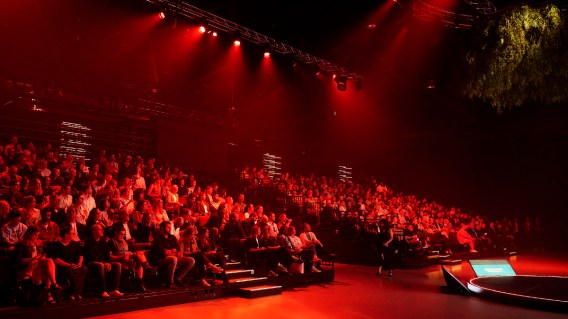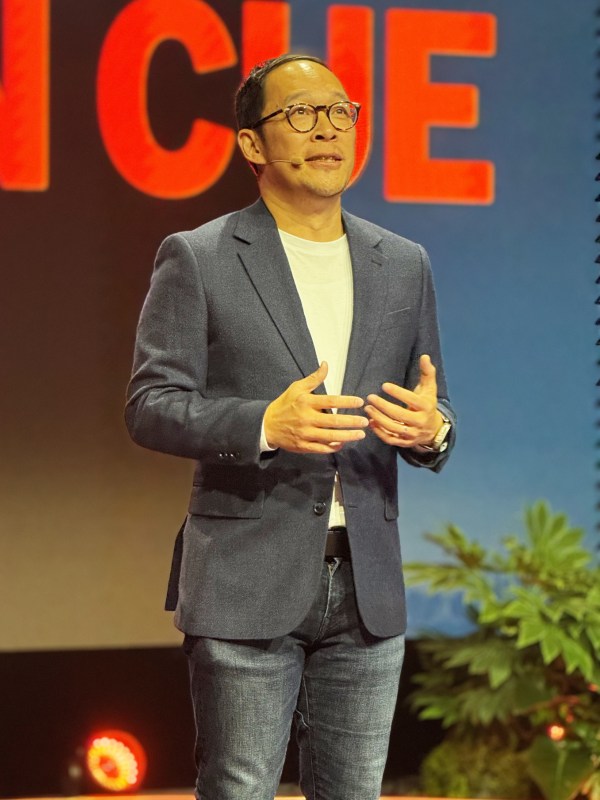
Content to commerce: Amazon looks to leverage its connection to sale
As the upfronts season rolls on TrinityP3’s Stephen Wright looks at how tech giant Amazon last night worked to leverage their connection to the transaction.

Many in the Amazon crowd had been at the Hordern already for the SBS and Youtube upfronts
Wednesday saw Australia’s adland return once again to the Hordern Pavilion (seriously SBS, Google and Amazon should have got a group rate).
They might have been the third media owner this season to use the venue for their Upfront and the versatility of the Hordern yet again came through. Each of the upfronts in this venue has been clever creating a customised atmosphere and story of its own.
Today’s pitch: Amazon has a powerful ‘end to end’ story and this certainly came through.
The delightful host Nina Oyama — star of Deadloch — kicked off proceedings and was the first to talk about funnels. The audience all nodded as she charmingly acknowledged that she was potentially the only person in the room that had no idea how funnels played a role in the advertising process. According to others who counted, the word “funnels” was mentioned no less than 17 times.
Enjoying Mumbrella? Sign up for our free daily newsletter.
Hwei Loke, Head of Prime Video for AU and NZ, talked us through a rich pool of largely overseas programme content (interspersed with a couple of original AU commissions) and we were left in no doubt as to the scale and appeal of the Prime offering.

Head of Prime Video Hwei Loke talking about basketball (Mumbrella)
Cricketer Pat Cummins was interviewed and delivered an amusing and insightful commentary on Amazon’s cricket coverage, proving that not all sports personalities need to be as wooden as the wickets.
Highlights of the schedule would be the hugely successful but quirky Deadloch, and mere mention of the global hit ‘The Summer I turned pretty’ received tearful oohs and gasps from a large contingent of the audience. Interestingly, however, there appears to be no season 4 of this hit show in the pipeline: season 3 appears to have reached a point from which the story is hard to extend. Show writers of popular series in the past have managed to have characters rise from the dead, so we shall see …
Perhaps the most impactful speaker was Amazon AU boss Willie Pang, who pointed out his company will continue to deliver audiences based on an “extensive library of hit shows”. Gone are the days where 7, 9, and 10 used upfronts to showcase the next local or overseas hits. The global tech/studio giants are here and they are pitching their content directly to agencies and advertisers.
Pang pointed out there is a wealth of existing library of content with additional viewing potential and ongoing audience delivery. Amazon isn’t solely reliant on the new. He then continued with the sales push in earnest.
Given Pang’s agency background he knew what the room wanted to hear. A lively and engaging presenter, fearless in the use of cliched sales messages. Of these, two in particular stood out:
“Streaming isn’t the future, it’s the now” was the first. The second was the power of owning the full funnel of “content to commerce”.

Willie Pang delivers his lines (Mumbrella)
The first point on streaming was a timely reminder of the struggles of some of the traditional free-to-air networks, and the migration of their audiences to digital. While some of the Australian TV networks have lent in more on streaming, others in the eyes of many agencies have been laggards, in many cases hamstrung by legacy sports rights deals (for example Seven and the AFL) that until this year did not include digital.
Overall, it’s hard to argue with the sentiment of Pang’s line about streaming, but perhaps only the bar staff and door security would have failed to register the self interest in the comment.
In the coming weeks we will hear the response from Seven and Nine, who have timed their upfronts for later in the season. It will be interesting to see their answer to the “slings and arrows’ of their streaming competitors.
Sun Tzu’s principle of “know your enemy” comes to mind. They will need to counter the streaming credentials that have been furnished by not only Amazon and Youtube, but also Foxtel and SBS.
The second sales mantra that Pang introduced was the power of “content to commerce”.
While Amazon might have started as a book retailer, it’s now a lot more: this is a powerful and highly credible line for them to prosecute.
The line anchored all the prior mentions of funnels, and set the stage for Amazon to make its pitch.
This really is what sets Amazon apart. As a partner, it is offering brands to be closer to the transaction in a way traditional media players can only aspire to. There will be many brands, particularly those in FMCG and broader retail, that will gravitate to the largest online shopfront in the market.
Competitors we have heard from previous upfronts are also actively reaching into this space with their new initiatives, for example Foxtel and Google with their retail announcements. But this is a space in which Amazon is the dominant force given their scale, reach and penetration.
The reality is: everyone else is playing catch up. The initiatives presented last night by Amazon in this area were less about introducing a retail option, and more akin to opening up a super-fast lane and express checkout. The execution will be what matters, but brands and agencies I spoke to last night were intrigued about the offering and its difference in an increasingly crowded TV market.
Stephen Wright is the global media lead of marketing consultancy TrinityP3.


